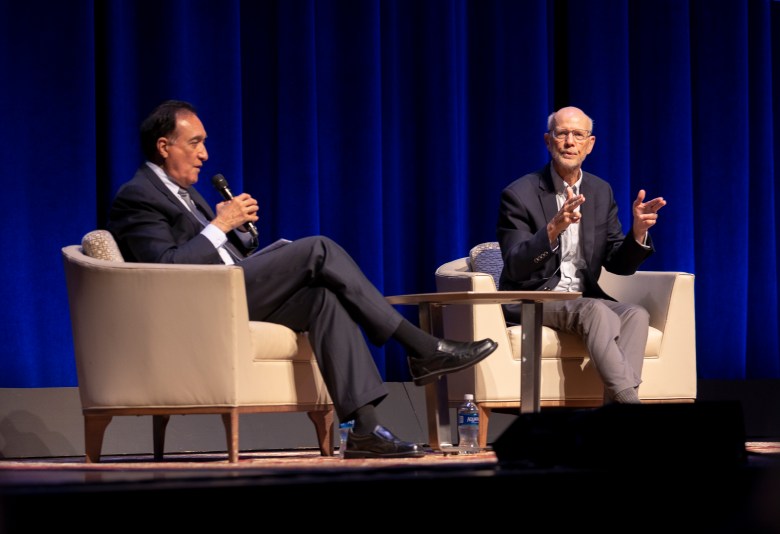- The Texanist: Texas Gets More Tornadoes Than Any Other State, but Don’t Freak Out
- U.S. Supreme Court says Texans can sue state for flood damage
- This is how many hurricanes NC State researchers predict this year
- NC State researchers predict above-average hurricane season
- Supreme Court rules in favor of property owners suing Texas over flood damage
CityFest keynote speaker Char Miller explains how floods shaped politics in San Antonio

Char Miller, San Antonio’s foremost environmental historian, considers the city’s violent floods the most important natural force in its 300-year history. His research draws a line from deadly floods to the city’s current political makeup.
“Floods reveal social structures,” Miller said. “They may power through a place and disappear, but what happens in those places is left behind.”
The former Trinity University professor left San Antonio in 2009 but continues to write books about the city’s history. He’s now a professor and director of environmental analysis at Pomona College in Claremont, California. San Antonio Report Editor Bob Rivard, who opened Miller’s keynote talk on day two of the news outlet’s four-day CityFest, joked that Miller was “San Antonio’s first remote worker.”
Miller’s latest book, West Side Rising: How San Antonio’s 1921 Flood Devastated a City and Sparked a Latino Environmental Justice Movement, is the most detailed history yet of the 1921 flood that ravaged the city’s West Side. Repeated floods led to a grassroots environmental justice effort that launched Citizens Organized For Public Service (COPS), which later joined with fellow organizing network Metro Alliance to form COPS/Metro, a group that’s still active in local issues.
The movement also led to the reorganization of San Antonio’s City Council from one where every candidate was elected at-large to its current form of single-member districts representing different parts of the city, Miller’s book details. This led to a political shift away from the Anglo-dominant structure that characterized City Council through most of the 20th century.
That’s why Miller told the audience that COPS “may have had probably the most profound influence on the city ever.”
The grassroots movement is what produced Henry Cisneros, who when elected in 1981 became San Antonio’s first Latino mayor since the 1840s. Cisneros, who later became Secretary of Housing and Urban Development, moderated the discussion with Miller on Thursday.
The conversation included Cisneros and Miller vividly recounting the fluvial violence that San Antonio suffered on Sept. 9-10, 1921. The floodwaters struck both downtown San Antonio and the West Side so fast that many people were still in bed as the waters outside their homes rose.
“Everybody says the exact same thing: they heard a noise, they hopped out of the bed, and they had ankle- or knee-deep water,” said Miller, who reconstructed the floods using archival records and press reports. “That’s how quickly the water arrived.”
Roughly 90% of the deaths, Miller said, occurred on the West Side, where many of the city’s working-class lived and worked in industrial sites, meatpacking plants, and produce hubs. They lived in homes built to the edge of the flood-prone creeks.
“They were jacales, they were shacks, for the poorest people of the city,” Cisneros said. “Pretty soon, the entire house was swept away with people.”
While the flood’s official death toll is around 80, Miller’s research indicates the authorites undercounted the dead, by only counting bodies, not people who were missing and never found.
“That way they could keep the count down for the national press and it wouldn’t look like San Antonio had been completely negligent because the death toll would have been massive,” Cisneros said.
Only two weeks ago, Miller said, a grave restorer sent him a picture of a grave of a mother and daughter likely killed in the flood. He didn’t recognize the name from any he had found in city records or newspaper archives.

Miller’s book and Thursday’s discussion also touched on how local authorities focused their flood-protection efforts on the city’s downtown business district, with the construction of the Olmos Dam in the 1920s. Immediately after the 1921 flood, the city committed $600,000 to “do something with the West Side creeks,” as Miller put it.

Readers like you keep our public service journalism free.
Our nonprofit newsroom publishes trusted reporting that enables residents to build a better city. But we can’t do this work alone.
The money ultimately went to labor on construction downtown and on the West Side. One of the projects was the municipal auditorium, completed in 1926. That building’s façade would later be incorporated into the Tobin Center for the Performing Arts, where Miller’s talk took place Thursday.
“This building siphoned away some of the flood monies that was committed to the West Side for its construction,” Miller told the audience.
Starting in the 1950s, federal flood control efforts, local organizing, building code updates, and a series of city and county bond initiatives have all contributed to protecting property all over the city from the heavy rains that still pummel San Antonio.
The latest transformation of San Antonio’s creeks and rivers is its 80-mile network of greenway trails, mostly built alongside the city’s interwoven waterways. Miller praised the trails system and said he often uses them when he’s in town.
“There is the physical manifestation of an entirely new way of thinking about San Antonio and the role that it plays in individuals’ lives,” he said.
Cityfest continues Friday with virtual panels on technology and journalism and the future of work, followed by a night of poetry with 2nd Verse in Legacy Park.
